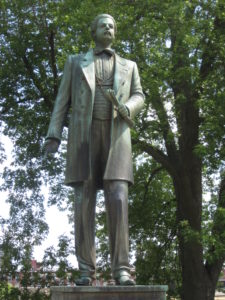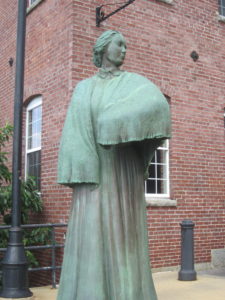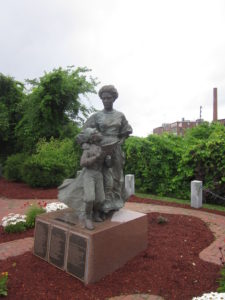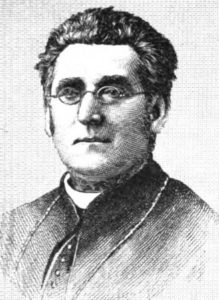[T]heir singular tenacity as a race and their extreme devotion to their religion, and their transplantation to the manufacturing centres and the rural districts in New-England means that Quebec is transferred bodily to Manchester and Fall River and Lowell.
– “The French Canadians in New England,” New York Times (June 6, 1892), 4.
By no means were French Canadians a “quiet presence” in New England cities at the end of the nineteenth century. By 1900, the French-Canadian population of Fall River and Lowell, Massachusetts, had grown to 33,000 and 24,800 residents respectively. In Manchester, New Hampshire, they numbered 23,000, a full 40 percent of the city’s total population. In many more industrial centers across the region, from Woonsocket, Rhode Island, to Waterville, Maine, the Canadians’ numbers rose steadily from the Civil War onwards. After a lengthy depression in the 1870s, there seemed to be no stopping the influx. Hardly a day passed, it seemed, without train stations witnessing the arrival of yet more families destined to swell the local “Little Canada.”
But it was not merely the immigrants’ numbers that drew the attention and consternation of American observers. As previously noted, French Canadians celebrated with imposing pageantry every June 24. In the host country, they built an impressive network of civic, cultural, and religious associations. They also altered the urban landscape of New England by building in more tangible ways: churches, schools, monuments, and eventually credit unions. As the cause of naturalization gained steam in the 1880s, French Canadians began to ascend into positions of power and influence outside of ethnic organizations. Here and there they became constables and selectmen; Woonsocket elected its first Franco-American mayor in the 1890s, and Winooski, Vermont, followed shortly thereafter.

The development of Franco-American communities may seem, in retrospect, peaceful and even unremarkable, especially as the immigrants embraced American institutions and earned praise as a law-abiding people. Their presence was regularly disputed, however, if not in the New York Times and high-profile magazines, then in local newspapers across the Northeast.
In places like Fall River, site of a budding labor movement, the immigrants antagonized other groups—especially English and Irish—by working as “knobsticks,” or strikebreakers. In the late 1870s and early 1880s, as the economy was recovering, French Canadians sought the immediate benefits of short-term work in New England factories. But their willingness to serve as strikebreakers, which certain observers exaggerated, was not a consequence of their chosen survival strategy exclusively. Coming from a rural background as many did, American organized labor was doubly foreign. Counseled by their Catholic priests, the Canadian workers wished to avoid getting mixed up in the public disturbances associated with strikes. The same Catholic guides also worried about the political ends—perhaps revolutionary—of American labor leaders.
Fall River, especially, became a rough place in the 1880s through vertiginous growth, heavy immigration, and the clash of various ethnic and working-class interests. Tensions were already running high when the Roman Catholic bishop of Providence, Thomas F. Hendricken, appointed an Irish pastor to a French-Canadian national parish in 1884—the spark for the “Flint Affair.” (Events unfolded in Fall River’s Flint Village.)


The Canadians of Fall River deployed all of the means at their disposal to challenge the rule of Fr. Samuel McGee in the parish of Notre-Dame, even borrowing the labor movement’s tactics. After failing to persuade Hendricken through dialogue, parishioners opted to disrupt and then boycott the church services—in essence, going on strike and depriving both the pastor and the church of financial means. In response, in February 1885, Hendricken placed the church under interdict.
Hendricken and the Canadians alike made their case in Rome. The latter argued that they had a right to a pastor of their own “race,” that the Catholic Church recognized nationality as an organizing principle. The bishop disagreed: neither he nor his peers could guarantee that an acceptable French pastor would be available. More importantly, from the beginning of the crisis, Hendricken sought to uphold episcopal power and prerogatives. The language of lay “rights” was foreign. To a reporter, he explained that the immigrants “are looking for a decision as an act of justice and necessity which, had they kept quiet, would probably have been granted to them long ago as a favor, which is the only way it could have been granted.”
Possibly under pressure from Rome, Hendricken reopened Notre-Dame in the fall of 1884. The latest pastor, an Irish-Canadian, ultimately stepped aside, enabling his assistant, Joseph Laflamme, to take the reins of the parish. Although Roman authorities had not endorsed the French-Canadian position, the accession of Laflamme enabled some activists to interpret the entire Flint Affair as a victory. This, in turn, would justify many more struggles against episcopal authority in decades to come.

Hendricken, who died shortly after the controversy, became a favorite bête noire of the Franco-American community. His actions seemed to emblematize the assimilationist intents of American (or Irish-American) bishops. But such designs are at best obscure when gleaned through the hundred or so national or mixed parishes that Catholic bishops created in the U.S. Northeast. As these clerical leaders quickly understood, the immigrants were more likely to desert the Church than to sacrifice their culture and language. Cultural accommodation was needed to prevent apostasy, to help the Church grow financially and in numbers, and to extend its influence. Even when they believed that French-Canadians would ultimately be assimilated, bishops took part in the ceremonial and cultural life of these immigrants.
But they refused to sacrifice their authority or the cohesion of the American Church, as subsequent controversies would reveal. Further, the Fall River case shows that historians must take into account other pressures that molded acceptance of French Canadians. Irish “labor priests” deserve special attention, for they had little regard for strikebreakers and opposed the creation of new national parishes—which meant dismembering existing parishes and thus a loss of worshippers and revenue. There, rather than in a dozen episcopal palaces, lies the greater part of assimilationist sentiment in urban New England.
As I conclude in my recent article on the subject,
Unlike the American Constitution, the Catholic Church in the United States was not blind to culture. The successive arrival of Irish, Germans, French Canadians, and Italians imposed difficult decisions upon bishops at a time when the Church had no formal policy on national societies and the establishment of national parishes. As mass immigration, much of it Catholic, boomed, the Church had great leeway in molding civil society and defining intercultural relations and did so without public oversight. In this, it justified Protestant fears of creeping un-American institutions and values. As Catholic prelates and laymen gathered for a national congress in Baltimore in 1889, the tide turned. Church authorities responded to the “[c]risis of the Eighties” by speaking against national societies and vaunting their patriotic credentials. To maintain the citadel required a change in tack. National parishes would remain, but the French Canadians of New England and other immigrant groups quickly were losing their most powerful allies in the preservation of their distinct culture.
Further Reading
P. Lacroix, “A Church of Two Steeples: Catholicism, Labor, and Ethnicity in Industrial New England, 1869-90,” Catholic Historical Review, vol. 102, no. 4 (autumn 2016), 746-770.
Leave a Reply